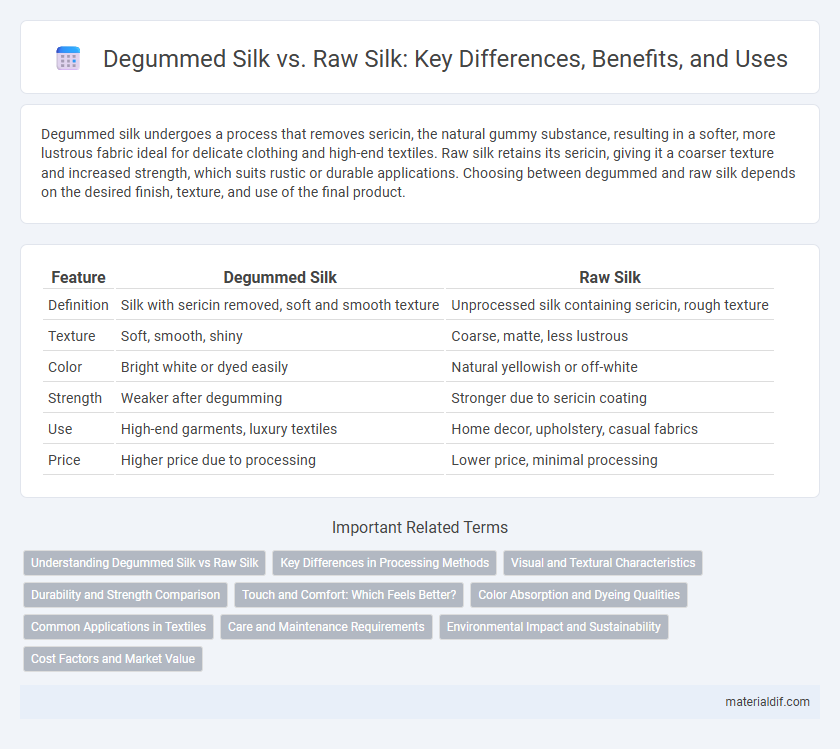Degummed silk undergoes a process that removes sericin, the natural gummy substance, resulting in a softer, more lustrous fabric ideal for delicate clothing and high-end textiles. Raw silk retains its sericin, giving it a coarser texture and increased strength, which suits rustic or durable applications. Choosing between degummed and raw silk depends on the desired finish, texture, and use of the final product.
Table of Comparison
| Feature | Degummed Silk | Raw Silk |
|---|---|---|
| Definition | Silk with sericin removed, soft and smooth texture | Unprocessed silk containing sericin, rough texture |
| Texture | Soft, smooth, shiny | Coarse, matte, less lustrous |
| Color | Bright white or dyed easily | Natural yellowish or off-white |
| Strength | Weaker after degumming | Stronger due to sericin coating |
| Use | High-end garments, luxury textiles | Home decor, upholstery, casual fabrics |
| Price | Higher price due to processing | Lower price, minimal processing |
Understanding Degummed Silk vs Raw Silk
Degummed silk undergoes a process that removes sericin, the protective gum coating, resulting in a softer, smoother texture ideal for high-quality textiles and apparel. Raw silk retains the sericin, giving it a coarser feel, increased durability, and a natural matte finish often preferred for upholstery and home decor. Understanding the differences in texture, durability, and applications helps in selecting the appropriate silk type for specific uses and fabric qualities.
Key Differences in Processing Methods
Degummed silk undergoes a thorough process to remove sericin, a gummy protein that coats fibroin fibers, resulting in a softer, shinier fabric ideal for fine textiles. Raw silk retains the natural sericin coating, providing a coarser texture and greater stiffness, often used in more durable applications. The key differences lie in degumming techniques, which involve boiling the silk fibers in alkaline solutions, whereas raw silk is harvested with minimal processing to preserve its protective sericin layer.
Visual and Textural Characteristics
Degummed silk has a smooth, lustrous surface with a shiny appearance due to the removal of sericin, making it softer and more refined to the touch. Raw silk retains the sericin coating, resulting in a coarser texture with a matte, slightly rough finish and a more natural, rustic visual appeal. The contrast between the two is evident in their tactile softness and the intensity of their sheen, with degummed silk favored for luxurious textiles and raw silk valued for its durability and organic look.
Durability and Strength Comparison
Degummed silk, also known as spun silk, undergoes a sericin removal process that enhances its softness but slightly reduces its tensile strength compared to raw silk. Raw silk retains the natural sericin coating, offering superior durability and higher tensile strength, making it more resilient for heavy-duty applications. The choice between degummed and raw silk depends on the desired balance of softness versus long-term strength and wear resistance.
Touch and Comfort: Which Feels Better?
Degummed silk offers a smoother, softer touch due to the removal of sericin, making it more comfortable and breathable against the skin. Raw silk retains its sericin layer, resulting in a slightly rougher texture that feels stiffer but offers greater durability. For everyday wear and luxury garments prioritizing comfort, degummed silk is often preferred for its silky softness and lightweight feel.
Color Absorption and Dyeing Qualities
Degummed silk exhibits superior color absorption and dyeing qualities due to the removal of sericin, allowing dyes to penetrate fibers deeply for vibrant, lasting hues. Raw silk retains its sericin coating, which can impede dye uptake, resulting in less uniform and more muted colors. The enhanced dye affinity of degummed silk makes it the preferred choice for high-quality, richly colored textiles.
Common Applications in Textiles
Degummed silk, known for its smooth texture and lustrous appearance, is widely used in high-end fashion garments, luxury bedding, and delicate scarves due to its refined finish and softness. Raw silk retains sericin, offering a coarser texture that is valued in upholstery, home decor, and casual wear for its durability and rustic aesthetic. Both types find unique applications in textiles, with degummed silk favored for elegance and raw silk preferred for strength and natural appeal.
Care and Maintenance Requirements
Degummed silk requires delicate washing with mild detergent and should be air-dried away from direct sunlight to maintain its smooth texture and sheen. Raw silk demands gentle handling as it retains sericin, making it less water-resistant and prone to stiffening if washed improperly; spot cleaning or dry cleaning is often recommended to preserve its natural fiber integrity. Both types benefit from low-heat ironing and storage in breathable fabric bags to prevent moisture buildup and fabric damage.
Environmental Impact and Sustainability
Degummed silk, processed to remove sericin, has a lower environmental impact due to reduced water and chemical usage compared to raw silk production, which retains sericin and requires less intensive processing. Raw silk's minimally processed nature results in higher biodegradability and less energy consumption, making it a sustainable choice for eco-conscious consumers. Both silk types offer renewable, biodegradable fibers, but choosing raw silk supports lower carbon footprints and reduced water pollution.
Cost Factors and Market Value
Degummed silk, processed to remove sericin, offers a softer texture and higher uniformity, resulting in a higher market value but increased production costs due to additional labor and chemical treatments. Raw silk, retaining its natural sericin coating, is less expensive and preferred for durability, yet it commands a lower market price reflecting its minimal processing requirements. Cost factors for degummed silk include chemical use and extended processing time, while raw silk's lower cost makes it attractive for applications prioritizing budget over refinement.
Degummed silk vs Raw silk Infographic

 materialdif.com
materialdif.com